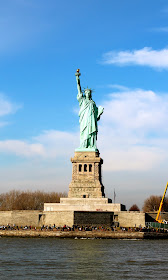There are certain places in New York that are suppose to only interest tourists (the Empire State Building, Times Square, Rockefeller Center). But I love history so I tend to ignore the tourist label if a place is historically significant. Which is why I found myself on a ferry last month, headed out to Ellis Island.
Ellis Island. The name conjures up old black and white images of women with scarves on their heads and little children clinging to their skirts while men wearing suits and handlebar moustaches stand nearby. In other words, something right up my alley.
The only way to get to Ellis Island is to take a
ferry, which makes two stops: the first at Liberty Island where most people
disembark to see the Statue of Liberty and the second at Ellis Island. I didn’t
get off at Liberty Island, happy to see Lady Liberty from the top deck of the
ferry (she’s actually much smaller in person save for her feet, which are huge).
My destination was the second island, the place nicknamed the Island of Tears.
Between 1892 and 1954 more than 12 million
immigrants passed through the doors of the immigration station on Ellis Island;
at its peak in 1907, more than 11,000 people were processed there daily. Today, 40
percent of Americans have an ancestor who came through Ellis Island, making it
perhaps one of the most important places in America.
During this time, ships would arrive at Hudson or
East River Pier where first and second-class passengers were allowed to disembark
after passing through customs (the general consensus was if you could afford
the fare, you probably wouldn't ask for charity from the state). Third class or
steerage passengers were sent via ferry to Ellis Island to be processed, which included undergoing a physical and intelligence exam. The majority of people
were allowed through within a day; those who were held on the island were usually kept
behind for medical reasons, political affiliations, or lack of funds to get to
their destination.
One of the many details on the main building.
Today the main building on Ellis Island is a
museum. Its imposing red brick and white limestone Beaux Arts style is
both stern and lovely at the same time. Inside, visitors can stand in the Great
Hall and imagine its vast space packed with people waiting to pass through registration
or wander around the three floors and see the rooms where the recently arrived
ate, slept, were examined, tested, and in some cases,
detained.
The Great Hall today.
Throughout the museum are numerous displays that
highlight the history of immigration in America from the various ethnic groups
that poured into New York to the prejudice and other challenges they encountered
once here to their great impact on American society and culture. Along with
countless photographs, maps, objects, and personal belongings (so interesting
to see what people felt compelled to bring with them) are audio recordings,
many of which are oral histories from people who were processed at Ellis Island. On the
walls are printed numerous stories, including my favourite from an Italian
immigrant who said "I came to
America because I heard the streets were paved with gold. When I got here, I
found out three things: First, the streets were not paved with gold. Second,
they weren't paved at all. Third, I was expected to pave them."
I started my visit with a talk by a park ranger and a viewing of a film Island
of Hope, Island of Tears, which
gives a good introduction to the place. There was so much
to see that I found myself having to hustle to catch the last ferry, the hours
having flown by while I immersed myself in history.
Back outside, I turned to look at the red bricks
rising against the blue sky with the grand streets and buildings of New York
waiting across the water and felt the power of the place—a great symbol of
hope.
If you’d like to visit Ellis Island, I highly
recommend buying tickets in advance. There are different options to purchase,
all of which can be found here.






No comments:
Post a Comment